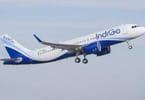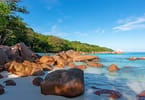NEW YORK — Two space tourism firms hoping to give fare-paying customers the rides of their lives are set to take some major steps forward in coming months.
On July 28, the suborbital tourism firm Virgin Galactic will unveil the first WhiteKnightTwo mothership for its planned fleet of SpaceShipTwo spaceliners designed by aerospace veteran Burt Rutan and his company Scaled Composites. Meanwhile, the Virginia-based company Space Adventures is preparing to launch its sixth paying customer on a $30 million trek to the International Space Station on Oct.12, with two more orbital hopefuls already waiting in the wings.
First up is Virgin Galactic, a firm founded by British entrepreneur Sir Richard Branson with the aim of launching up to six paying customers and two pilots on joy rides to suborbital space for about $200,000 a seat.
At the core of Virgin Galactic’s reusable spaceliner fleet is SpaceShipTwo, an air-launched suborbital spacecraft derived from Rutan’s $10 million Ansari X Prize-winning SpaceShipOne design. Virgin Galactic has ordered five SpaceShipTwos and two of their immense WhiteKnightTwo motherships, the first of which has been christened “Eve” after Branson’s mother and will be unveiled at a Scaled hangar at the Mojave Air and Space Port in Mojave, Calif.
“We’ll be rolling this carrier out of the hangar for the first time on July 28, and shortly afterward it will start its test program,” Virgin Galactic commercial director Stephen Attenborough said Wednesday during the 2008 Space Business Forum held here by the non-profit Space Foundation. “It will be the world’s largest all carbon composite aircraft…it breaks all sorts of records.”
With a unique dual-boom design, Rutan’s WhiteKnightTwo sports a wingspan of about 140 feet (42 meters) with each outboard cabin mounted about 25 feet (7.6 meters) from its centrally moored SpaceShipTwo payload. About 254 people have paid a total of about $36 million in down payments to assure their SpaceShipTwo seats once the spacecraft begins operational flights. The suborbital vehicle itself is slated to be unveiled early next year, Virgin Galactic officials have said.
The carrier craft is also designed with the capability to haul unmanned rockets in place of a crew-carrying vehicle, and could one day be used to launch low Earth orbiting satellites or even cargo into space, Attenborough said. With its 18-inch (46-cm) windows and roomy 7.5-foot (2.2-meter) wide cabin, SpaceShipTwo could also be used for suborbital science experiments in addition to leisure trips, he added.
“We built a big spaceship,” Attenborough said. “It’s going to have plenty of room in there for the scientists and the experiments they’re going to do in there.”
Aiming for orbit
Later this year, Space Adventures plans to launch American millionaire Richard Garriott, the son of retired NASA astronaut Owen Garriott, to the International Space Station under a $30 million agreement with Russia’s Federal Space Agency.
Garriott is set to launch Oct. 12 aboard a Russian Soyuz spacecraft with the space station’s Expedition 18 commander Michael Fincke of NASA and flight engineer Yuri Lonchakov of Russia’s Federal Space Agency.
Garriott is the sixth space tourist to hitch a ride to the station with Space Adventures, which has been the only firm to offer multimillion-dollar treks to orbit since the landmark flight of American entrepreneur Dennis Tito in 2001. Last week, Space Adventures announced its intent to launch the first all-private Soyuz flight to the space station in 2011 and welcomed Google co-founder Sergey Brin to its ranks of hopeful private spaceflyers.
“We are a company that is amazingly now 10 years old,” said Eric Anderson, Space Adventures president and CEO, during the forum, adding that there are a host of opportunities still ahead for his firm. “We’re sort of at a crux and looking ahead toward the next 10 years, so anything is possible.”
In addition to Garriott, Space Adventures has contracts for two more orbital tourists — the seventh and eighth private spaceflyers — though their identities have yet to be publicly revealed, Anderson told SPACE.com.
George Nield, the associate administrator of the Office of Commerical Spaceflight at the Federal Aviation Administration, said the strides by Virgin Galactic, Space Adventures and others are just the beginning of a potential watershed for the space tourism industry.
“Today, spaceflight as we’ve known it for the last half century is at the doorway to change,” Nield said during the forum. “We’re on the threshold of seeing what we think will be a very significant market on suborbital flights for space tourism.”
Ambitious commercial endeavors, he added, are also taking on a larger role in the U.S. spaceflight industry that was traditionally reserved for government agencies in the past.
“This is not your father’s version of the U.S. space program,” Nield said. “The future of space belongs to private enterprise.”
ohere.com
IHE Ị GA-Ewepụ na edemede a:
- Garriott is the sixth space tourist to hitch a ride to the station with Space Adventures, which has been the only firm to offer multimillion-dollar treks to orbit since the landmark flight of American entrepreneur Dennis Tito in 2001.
- George Nield, the associate administrator of the Office of Commerical Spaceflight at the Federal Aviation Administration, said the strides by Virgin Galactic, Space Adventures and others are just the beginning of a potential watershed for the space tourism industry.
- First up is Virgin Galactic, a firm founded by British entrepreneur Sir Richard Branson with the aim of launching up to six paying customers and two pilots on joy rides to suborbital space for about $200,000 a seat.






















